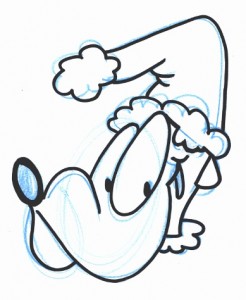
This is how I start. I sketch with a non-photo blue pencil and then ink over the lines. The drawing gets scanned in Xsane and then imported into Gimp where color is added.
“How’d ya do that?” I get this question as often as I get , “How do you get your ideas?” And, of course, the first question refers to the kinds of digital tools I use to help produce my cartoon features and images for my blog posts.
Since moving over to Linux, I’ve been using the graphics applications the come with this wonderful OS. And I use them exclusively to produce all my cartoon features. The Gimp (photo editing) and Scribus (Desktop publishing), especially, do a great job in helping me create my cartoon features for newspapers and other print publications.
In addition to my print features, The Gimp and Scribus both proved quite handy when I recently prepared a special blog post.
If you’re a reader of this blog, you already know that, this year, I decided to offer a George Christmas ornament to all my readers. I used the Gimp and Xsane (the Linux scanning utility) to prepare all the art. I drew a festive George complete with Christmas Santa cap. Using Xsane, I scanned it at 600 DPI and brought it into Gimp. (For the uninitiated, Gimp is the Photoshop equivalent in the Linux world.)
Once I have it Gimp, it’s easy to add all the color. The Gimp is as easy to use as Photoshop or any other photo editing software.
Since I know I’ll be using this art in Scribus, I usually save my cartoon images as .png image files. Doing so allows me to give them a clear background. When I bring the .png file into Scribus, I can then make use of the clear background to layer over other images. Scribus also allows me to drop a color background into that clear area.
Now that the art is complete in Gimp, it’s then a very simple matter of importing it into Scribus and laying it all out on the page. Scribus is a really powerful desktop publishing software app! It has all the tools you need to layout a newsletter, magazine page, greeting card, web publication…whatever kind of print publication you need!
For the ornament, I used the shape tools to create the round ornament with green background field. I used Scribus’ text tools to drop in the text. Scribus has a nice drop shadow tool which will add that effect to the text. It’s really very handy. After I get it all laid out, I then export as a PDF and upload that file to my blog. I linked to the PDF file so blog readers can now, through the click of the mouse, get a free paper George 2010 Christmas ornament!
Again, you can get the ornament, too, by visiting this blog at the following page: http://www.georgetoon.com/blog/an-early-christmas-gift/
If you want to give someone a great gift this Christmas, give them Linux! It’s free, powerful, stable, secure, and fits just about any computer system. And all the software mentioned in this article (along with hundreds of others) is absolutely free with Linux! Many are even pre-installed. When you install Linux, you install all this great software at the same time!
Merry Christmas and Happy New Year!



Yay !
Thank you very much Mark ! I have been eagerly waiting for this tutorial 🙂
You know, I a’ways thought you used Gimp with Inkscape – but I should look into Scribus – I never tried it !
My favourite thing to do on Inkscape this days is play with the calligraphy pen tool. And it supports Right-to-Left languages with Adobe products don’t.
.png is my favourite file format.
I’ve used Inkscape in th epast and need to use it more. As I recall, it’w quite powerful. for the moment, Scibus does what I need. As my designs require more tools, I may move over to Inkscape. It’s all a matter of learning the moves of the application. Scibus took a little getting used to. But once you understand working with layers, and keeping elements on their own layers, it becomes quite easy. You’ve inspired me to fire up Inkscape and start exploring it again!:)